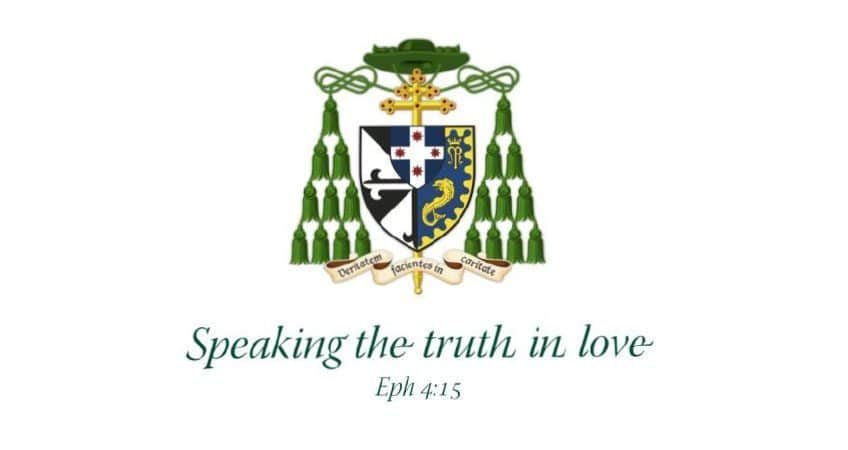HOMILY FOR THE SOLEMN PONTIFICAL MASS FOR THE 4th SUNDAY OF ADVENT Year B

St. Mary’s Basilica
All creation is hushed. The angel and millions of his heavenly comrades all strain to hear the girl’s response. In their limbo Adam and Eve, the patriarchs and prophets, and all the dead, listen attentively. All the living, man and beast. Birds of the air and fish of the sea stop in their tracks. Ox and ass and lamb fall silent and crickets too. The celestial orbs stop in their course as sun and moon eavesdrop on the scene.
Sandro Botticelli, Cestello Annunciation (1489), Uffizi Gallery Florence
What will she say? The first Eve said NO, I will not obey, will not serve. What of this new Eve? Fear first, uncertainty, questions, a pregnant pause… “Yes, I am God’s handmaid, His will be done in me.” Creation explodes with excitement greater than any football crowd, more exhilarated than those at the New Year’s fireworks. Not just good news, it’s the best news ever. Mary’s YES is not just the fiat of a humble young maid: it implicates us all. At last a human being has said YES with all her heart where so many before have said NO or MAYBE. Spokesperson for creation, Mary willingly accepts God’s offer of re-creation.
Why do we hear the story of the Annunciation (Lk 1:26-38) five days out from Christmas? Though their biological knowledge was imperfect, even the ancients knew it took nine months, not five days, from conception to birth. That’s why the Annunciation is celebrated on 25th March. (Occasionally Holy Week or the Easter octave bumps it into April: in those years the Baby is born prematurely!) Nine months allow plenty of time to reflect upon events in-between: the Visitation to Elizabeth, the Dream of Joseph, the Marriage of the Virgin, the Naming of John, the census of Caesar and the Journey to Bethlehem.
But what light does the Annunciation cast upon the Nativity? Well, together this twin-feast celebrates the great mystery of the relationship between God and humanity, and that most extra-ordinary event bridging the two that we call ‘the Incarnation’.
Jean-François Millet, The Angelus (1858), Musée d’Orsay
Since the pandemic began we’ve heard the Angelus ring out over our city more than ever — in places like this at dawn, 9 a.m., noon, 3 p.m., sunset and even at 9 p.m. Each time, we recall when the angel declared and the Virgin consented, the Spirit overshadowed and the Babe conceived, the Word was made flesh and dwelt among us. In Christ, God takes upon Himself our humanity without in any way diminishing His divinity.
This extraordinary happening establishes several things. One is this: some of the ancients thought the material universe inferior, even evil, and so sought to free the soul from the body, the spiritual from the material. But by taking flesh God confirms that all creation is inherently good — for He could not be joined to that which was other-than-good. After the Resurrection, Christ doesn’t cast off his humanity like a snake sloughing its skin: He remains human in body and soul, forever. Just as there is no re-incarnation, so there is no de-incarnation either. All this has implications for our veneration of the natural world, of bodily life, of the Eucharist, marriage and the other sacraments, and of the dead. It is part of why killing human beings, especially the youngest and oldest, is so unthinkable for us.
But if the Incarnation confirms the inherent goodness of creation, it also highlights its brokenness. By sin humanity has damaged itself and everything around it, and ‘socially distanced’ itself from God. Things are not as they should be. Yet healing is possible, including restoration of the image and likeness of God in us, return to that intimacy we once enjoyed with God, and reintegration of personality and relationships. By virtue of the incarnation even more is possible for human beings than was before the Fall: for now we are not only healed but elevated, adopted into the family of God.
So our double feast lays out the doctrines of the Incarnation, Creation and Redemption. But there is more. Mary has the gifts of human intellect and will, and a giant helping of divine grace. So when called she responds freely and well. Her YES restores the right order between God and humanity: God inviting and us accepting, God directing and us obeying, God befriending and us loving back. He enables but never forces our hand. We are free to love and serve Him or not. God could have taken human form without any human consent or contribution. He could have decreed redemption without ever taking our nature. But He chose to save us by our co-operation.
Creation and Redemption, Grace and Responsibility, Christ and one more thing… the Church. Traditionally we say the Church was born at Pentecost. But Paul VI – who visited this cathedral 50 years ago last month – suggested that Mary’s fiat is not just a private offer of herself: she offers creation, offers all humanity, in one great YES to salvation, making herself Mother of all the living,[1] and so constituting the Church.
Secular models of service — as in the public service, service industries, military service or service with a smile — have various motives and are often given begrudgingly but with a veneer of courtesy. That’s certainly better than rudeness or denial of service. But Christian service is different. The Greek word for service is λειτουργία (liturgia) which is why the sacred liturgy is sometimes called ‘divine service’. The Annunciation and Christmas are about divine service, as an angel and a cousin recite the Hail Mary, Mary responds with her Magnificat, angels sing the Gloria while shepherds and kings adore. But this divine service is service of neighbour also. So Mary goes straight from the Annunciation to the hill country to attend her pregnant cousin Elizabeth; shepherds and kings come not just to gawk but to contribute; the Marian YES is not just passive or notional: it is enacted.
Dear brethren, your presence here today and every Sunday, your commitments to God, Church, family and community, your good words and deeds, all amount to a Marian YES for which I thank you with all my heart. Creation stretches to hear what you will say each day, as it did to hear Mary. By your lives too, you say YES to God, that you are ready to be inspired by the Holy Spirit and willing to bear Christ in your own life. There is no better preparation for Christmas!
INTRODUCTION TO THE SOLEMN PONTIFICAL MASS FOR THE 4th SUNDAY OF ADVENT Year B
Welcome to St Mary’s Basilica in Sydney for the Solemn Mass of the 4th Sunday of Advent. As Christmas is only five days away, today is a final wake-up call for us all!
It has been a joy to gather in greater numbers at Mass, and I hope to see many more in five days’ time. But the recent breakout of COVID in parts of Sydney has underlined how fragile is our current safety and so we must keep praying and acting to bring an end to this pandemic. We pray today for our civic leaders and health authorities as they lead us through this. Subject to any new restrictions in the days ahead, please plan to bring someone along to Mass and Christmas who might like to do something spiritual but wouldn’t come without your prompting.
In this final strait to Christmas we are exhorted to make a good Confession. But for venial or less serious sin it is enough to be truly contrite and say the Confiteor as we are about to do. So, to prepare ourselves to receive the Christ-child into the crib of our hearts, let us repent of our sins…
[1] Paul VI, Marialis Cultus: Apostolic Exhortation on the Right Ordering and Development of Devotion to the Blessed Virgin (1974), 6

